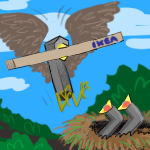|
Keyboard brass is always the toughest thing to get 'right', even 60gb £600 kontakt libraries still struggle.
|
|
|
|

|
| # ? May 10, 2024 11:00 |
|
To do brass right you need to control a handful of performance parameters simultaneously. There are a lot of idiosyncrasies that don't easily translate from a keyboard, like bending up towards a note and tonguing, muting, falsetto and stuff like that. The quality of the timbre itself isn't all that critical, relatively. It's easier to implement in synthesized timbres than with sample libraries, that would have to have sample variations for all sorts of combinations and would have to be scripted to hell and back for performers with more than ten fingers. On a budget, it's maybe more sensible to get some older module that has accommodations for a breath controller (ie has midi parameters supported beyond pitch bend and actually does something with them) than to go with whatever has the most GB of samples. Although really clever scripting does exist in software these days. And it would require some specific training to get the most out of such a module if not used with an actual breath controller. Here are some brass programming tips from Rob Young's book The Midi Files that I posted earlier in the context of a similar question in another thread:  I don't know if it will help what you're doing but it gives an idea of the sort of considerations that make a brass patch sound more like brass. In short, it's a hard thing to do right.
|
|
|
|
This may be a bit of a pipe dream, but is there any better option for jamming online other than Skype? I'm working with my bass player on some parts for a few songs, but things are a bit hectic during full rehearsal, we both have full day jobs, and live about an hour apart. My hope is for something that can connect two people, blend instrument signals from audio interfaces coming from each computer, and allow for a modicum of jamming that doesn't rely on a complicated set-up process or dealing with balancing a bunch of Skype stuff that I'm never good at dealing with. Am I imagining that such software exists?
|
|
|
|
Flipperwaldt posted:To do brass right you need to control a handful of performance parameters simultaneously. There are a lot of idiosyncrasies that don't easily translate from a keyboard, like bending up towards a note and tonguing, muting, falsetto and stuff like that. The quality of the timbre itself isn't all that critical, relatively. It's easier to implement in synthesized timbres than with sample libraries, that would have to have sample variations for all sorts of combinations and would have to be scripted to hell and back for performers with more than ten fingers. or just get Sensual Saxophone by Embertone https://www.youtube.com/watch?v=GPerClU9yVE that way you also get a big purple sex knob (if you don't have one already)
|
|
|
|
Hedningen posted:This may be a bit of a pipe dream, but is there any better option for jamming online other than Skype? Haven't used it, and it hasn't been updated in a long time, but you could try Ninjam
|
|
|
|
So my amplifier has a small spring reverb (80s Crate G-20) which I've always just cranked to full and left on because it doesn't add a lot of reverb, just some nice extra thickness to the sound. This amp also doesn't move around at all, so it hasn't been dropped or anything, but of late, having the reverb on is causing something in the amp to start feeding back. It doesn't overwhelm whatever signal is being put into the thing, it's just there in the background like you left the tv on in the other room and it's doing a test of the emergency broadcast system. It's not a world-shattering loss, I was planning on getting a reverb pedal anyway to replace the one I had to sell off some time back, but is there anything I can reasonably do to see about tracking down and possibly repairing the fault in the tank or whatever it is that might be making it do this?
|
|
|
|
I have one of those daisy chain one spot things that has five outlets and an input. Is it safe to cut off one end of it to make it so it only has two of those things?
|
|
|
|
Probably, as long as you insulate the bare ends. Not sure why you would though. Just wrap up the unneeded connectors with tape and they'll be there if you ever do need them.
|
|
|
|
|
My band recorded a short album and ordered a small run of CDs for physical distribution (custom printed CDs, decent disc jacket, etc). To save money, we ordered the CDs blank and are burning the songs to disc ourselves. So far we have burned as mp3 CDs, but some people have reported issues playing them back in some cars, etc. Is there a more universal format method to successfully burn CDs instead of making shiny drink coasters? Yes, we have digital distribution, but COOL ARTWORK and so on
|
|
|
|
The Science Goy posted:My band recorded a short album and ordered a small run of CDs for physical distribution (custom printed CDs, decent disc jacket, etc). To save money, we ordered the CDs blank and are burning the songs to disc ourselves. So far we have burned as mp3 CDs, but some people have reported issues playing them back in some cars, etc.
|
|
|
|
Flipperwaldt posted:Does the bolded bit mean "cd-rom with the mp3 files on there as files"? Sort of; mp3 cds are an actual thing, formatted in a way that mp3 cd players could read them. However, a normal cd player cannot. Mp3 cds might've caught ob if the iPod never happened. To answer the original question, don't make mp3 cds. Look up Redbook audio and do that. It'll give you max 70 minutes per disc, but every cd player will be able to use them. ITunes can make Redbook cds no problem if you don't have a better option.
|
|
|
|
"Sort of" is hedging your bets too much. It's exactly the same thing. The reason I asked the question is to find out whether the other poster was using redbook already, but maybe using the wrong terminology. In which case this would be a different type of problem.
|
|
|
|
Flipperwaldt posted:"Sort of" is hedging your bets too much. It's exactly the same thing. Ah, I misunderstood. I thought you were just referring to a data disc with mp3s on it, and not an actually-formatted MP3-CD or however it's officially written. I don't even remember what colour 'book' it is. Edit: wait, nm... Now I'm confused. Wasn't that what you were referring to?
|
|
|
|
Rupert Buttermilk posted:I thought you were just referring to a data disc with mp3s on it, and not an actually-formatted MP3-CD Here are the highlights from the wikipedia page: quote:A compressed audio optical disc, MP3 CD, or MP3 CD-ROM or MP3 DVD is an optical disc (usually a CD-R, CD-RW, DVD-R or DVD-RW) that contains digital audio in the MP3 file format. Discs are written in the "Yellow Book" standard data format (used for CD-ROMs and DVD-ROMs)
|
|
|
|
Our drummer says he has been burning them through iTunes as "mp3 CDs" so they are not Redbook standard audio CDs. I'll double check our master files, confirm that they are 44.1/16, and use "Audio CD" for our future disc burns. Thanks for the replies!
|
|
|
|
Flipperwaldt posted:These are both the same thing. There's no separate standard. Ah, ok, thanks! Man, I forget something and then relearn it again every day! Cheers. The Science Goy posted:Our drummer says he has been burning them through iTunes as "mp3 CDs" so they are not Redbook standard audio CDs. Be sure not to just convert your mp3s to wav, as that won't improve the actual quality. Edit: Joke reply - "Friends don't let friends get their drummers to be in charge of anything"
|
|
|
|
I guess this might be the right thread for this. There's not really a thread for poo poo like this and I don't really want to post one(I think) but I'm kicking around some thoughts and don't have anyone to particularly discuss them with so gently caress it. I play clarinet with my dad's noise music outfit, and they do weird synthesizer poo poo that is semi-random, no rules, no cadences, no defined beginning, end, or anything else. In this setting, anything tonal is going to sound cheesy and hackneyed; even the idea of a musical phrase is pretty much out the window, for the most part. Playing improvisatory clarinet in this setting is a whole different beast than in a jazz quartet or something with obvious and understood tonal goals. My approach to it has been to embrace the inherent instability in the situation and approach playing an ostensibly tonal, fully chromatic musical instrument from the opposite side of tonality - that is, less organization, no tonal goals, no cadences. To actually play anything with this in mind, I have started to practice a style of improvisation that relies on stacked minor thirds(diminished chords), stacked major thirds(augmented chords), whole tone scales, octatonic scales, and pentatonic scales. My goal is to be able to fluently switch between musical modes that do not allude to a single key, or two keys(major/minor) or any tonal center at all, but rather play in modes that feature equidistant intervals and chords that allude to as many keys as possible at once. What I'm wondering is, does anyone know of any music that uses this type of tonal aesthetic? Am I missing any other tonally ambiguous approaches to playing a tonal instrument? I'm thinking I need to get really good at playing quartal harmonies - playing in fourths - and open fifths without filling in the third. My goal is to be able to play in what I'm thinking of as 'the key of instability' that can stay fresh and interesting while playing without a tonal goal, and will basically trick the listener's ear into thinking it's hearing recognizable musical elements for brief instants before ignoring the expectation that was just set up. Sorry if this isn't the place for this, I just don't really know what is.
|
|
|
|
Sounds like serialism would be right up your alley. The Wikipedia article on it references a lot of composers who used it: https://en.m.wikipedia.org/wiki/Serialism
|
|
|
|
I can't help, sorry, but this... empty whippet box posted:I play clarinet with my dad's noise music outfit ... Needs to be the thread title or your custom text, or something, because holy poo poo. I love it
|
|
|
|
Rupert Buttermilk posted:Be sure not to just convert your mp3s to wav, as that won't improve the actual quality. It looks like our current mp3s are 48k, so I'm going to re-encode the lossless original files to the proper sample rate with LAME and use those for the audio CD burning. I joined the band after the album was completed (I had no part in the recording or mixing) otherwise I would have done this research before the discs were even ordered.
|
|
|
|
The Science Goy posted:It looks like our current mp3s are 48k, so I'm going to re-encode the lossless original files to the proper sample rate with LAME and use those for the audio CD burning. I joined the band after the album was completed (I had no part in the recording or mixing) otherwise I would have done this research before the discs were even ordered. You're just trying to make normal CDs right? Forget MP3s, use whatever burning software you have to create an Audio CD, add your original lossless files in the order you want, that's it You might have to convert to WAV or something if your originals are in some format like FLAC and the burning software can't convert automatically. But there's no point converting to MP3 just to go right back to lossless again, even if you can't hear any degradation you might get glitches around the track endings If you actually do want MP3 CDs (i.e a CD-ROM that happens to have a bunch of MP3s on it) then yeah you probably want the most vanilla encoding and storage setup, but I'm guessing you don't want that anyway? It's not exactly a common thing for CD players to handle. So long as your stuff is less than 74/80 mins long (depending on your discs) a normal audio CD is the most universal
|
|
|
|
Hawkgirl posted:Sounds like serialism would be right up your alley. The Wikipedia article on it references a lot of composers who used it: https://en.m.wikipedia.org/wiki/Serialism Yeah, I'm familiar, I suppose I should have said, I am ABD for my DMA in clarinet performance and pedagogy. How could I apply serialism to an improvisatory context though? How can I constantly go nowhere while improvising, but trick the listener into hearing whatever order they're inclined to impose over what is mostly, but not entirely, chaos? Rupert Buttermilk posted:I can't help, sorry, but this... Last show we played was at a record store in new orleans and I was high as gently caress on LSD. It's pretty out there. empty whippet box fucked around with this message at 02:55 on May 6, 2017 |
|
|
|
empty whippet box posted:Yeah, I'm familiar, I suppose I should have said, I am ABD for my DMA in clarinet performance and pedagogy. How could I apply serialism to an improvisatory context though? How can I constantly go nowhere while improvising, but trick the listener into hearing whatever order they're inclined to impose over what is mostly, but not entirely, chaos? Oh lol, sorry. So here's what I'm thinking. You likely had to dick around with serialism in your theory classes like I did and could probably easily produce a few sets. And improvisation is largely based on learning a large number of licks, so that you can use your mental library to combine those licks in new and cool ways. And it seems like your main problem is mainly that you do know a lot of licks...just not the right kind. So make a few serialism matrices for notes, maybe even serialize some rhythmic patterns to match, and start practicing them like they're major scales or jazz licks. Like I'm pretty sure you're just missing basically "fluency" in atonalism and this seems like a good way to develop some.
|
|
|
|
Hmmm, playing in the set of 0146 or 0235, etc...in an Improvisatory way does sound promising. I'm sure each set would sound unique. Practicing this will really annoy the neighbors! And I guess while I'm here, here's a track from one of our live shows: https://m.soundcloud.com/bongoloids/rampage-of-the-little-professor Bunch of other weird poo poo on there too. If you hear a clarinet it's me. empty whippet box fucked around with this message at 04:08 on May 6, 2017 |
|
|
|
empty whippet box posted:tonal aesthetic: 'the key of instability' Cool post. Thanks for naming my autobiography
|
|
|
|
empty whippet box posted:I guess this might be the right thread for this. There's not really a thread for poo poo like this and I don't really want to post one(I think) but I'm kicking around some thoughts and don't have anyone to particularly discuss them with so gently caress it. You keep referencing stacked thirds, scale types, the whole lot of it -- just disregard all that bullshit. You aren't going to plan that way to the type of improvisation you want to achieve. I don't know anything about clarinet but are there some mechanical features of the instrument you can exploit? I'm thinking less "playing notes" and more "loving voodoo duck squealing." I truly think you need to harness some utter contradictions within yourself to keep up with the band that there is no keeping up with. Honestly this topic just excites me to no end. Its like Watson and Crick finding the double helix. I guess you should start with a droning approach that agrees with the other tones around you -- or completely disagrees even, and then build repetitiously. If there is one thing I've noticed in all the weird noise music it is this idea of introducing repetition, but also masking it. You'll be playing a phrase or something ad nauseam but with a subtle enough dynamic approach that you'd have to be listening for more than two minutes to really "catch on" to it. Try to be repetitious whatever you do, but make it subtle. I think that is a good start. Literally play the same phrase of the pentatonic scale, or the same four notes of it over an over. I've noticed seeing amateur "noise" acts that they will hit a really good sound but then for no other reason than their own impatience will change up the drone/sound and I think 'no! go back to that other thing!' Imagine yourself in a staring contest with the crowd as you improvise. 20 Blunts fucked around with this message at 00:35 on May 12, 2017 |
|
|
|
Peetown Manning posted:You keep referencing stacked thirds, scale types, the whole lot of it -- just disregard all that bullshit. You aren't going to plan that way to the type of improvisation you want to achieve. 'loving voodoo duck squealing' is a common feature of my noise improvisation, I'm pretty good at making the sounds you're not supposed to make on a clarinet. And portamentos and wide smears, I can actually bend a note up or down further without breaking it than a trombone can. One thing I like to do is wildly improvise as randomly as I can while actually using conventional scales and arpeggios without resolving them in any way, to sort of 'prove' to the audience that I am actually doing everything on purpose, and then start doing shrieking, howling pitch bends and sounds that people usually associate with 'mistakes' like squeaks, growling and multi phonics. Basically, I'll play in such a way proves that I'm doing this stupid bullshit on purpose and then play in such a way that you'd think I have no control over my instrument whatsoever if you hadn't just heard the previous section. I love leaving the audience utterly confused as to what I am doing or why I am doing it, while actually having some kind of 'controlling element' that I'm playing around with like a focus on diminished arpeggios or moving in a circle of fifths or tritones. If someone ever actually tried to claim that I was simply playing randomly, I'd be able to concretely prove that I wasn't. There's some examples of crazy duck squealing and noises which are traditionally considered to be 'mistakes' in the link I posted previously, I think. Also, you're spot on about repetition - what you describe about hitting good sounds and repeating them subtly is something I definitely have heard many times playing in a 'noise' setting. I definitely get annoyed when we move on too quickly from them, but I think that's also part of what keeps it fresh and 'on the edge' - being willing to say 'ok, we've done this thing for 30 seconds, let's do something else' even if that might not be as 'good.' It's kind of scary and exciting and fast-paced. empty whippet box fucked around with this message at 02:36 on May 15, 2017 |
|
|
|
I have some tracks that are 50 cents flat and I'd like a quick and dirty way to tune them up in Cubase. I have a pitchshifter vst but it colors the sound in an undesirable way. I was thinking it would be nice to be able to tune things in my DAW the way you can with an old school tape cassette recorder, by speeding them up or down slightly. Is there a VST that will let me do this with accuracy, or a way to bounce the tracks mess with the sample rate for precision tuning?
|
|
|
|
Drink-Mix Man posted:I have some tracks that are 50 cents flat and I'd like a quick and dirty way to tune them up in Cubase. I have a pitchshifter vst but it colors the sound in an undesirable way. I was thinking it would be nice to be able to tune things in my DAW the way you can with an old school tape cassette recorder, by speeding them up or down slightly. Is there a VST that will let me do this with accuracy, or a way to bounce the tracks mess with the sample rate for precision tuning? You can do this natively in reaper by changing the track bpm
|
|
|
|
Drink-Mix Man posted:I have some tracks that are 50 cents flat and I'd like a quick and dirty way to tune them up in Cubase. I have a pitchshifter vst but it colors the sound in an undesirable way. I was thinking it would be nice to be able to tune things in my DAW the way you can with an old school tape cassette recorder, by speeding them up or down slightly. Is there a VST that will let me do this with accuracy, or a way to bounce the tracks mess with the sample rate for precision tuning? You'll have to do the calculations of how many % you'll need to adjust manually though. There's a guy explaining how here, but maths break my brain. The pitch shifter in Audition suggests around +2.93% for 50 cents upwards, if I'm reading this right. Chances are I'm not, since its scale references play duration instead of speed offset. But it should be in the ballpark. If you have a tuner app like pitchlab on your phone listening to the preview, it'll probably help. A VST can't do it, because it can't feed back the change in play duration to the DAW, it can only process what it's fed in real time. I didn't really find a free solution that was more elegant and convenient, which surprised me. There are a lot of online calculators that calculate everything but this (+/-pitch adjustment in cents to +/-sample rate or +/-%).
|
|
|
|
I was recruited to play keys and synths for a 80s and 90s rock cover band. What do other keyboardists here do on songs that have no native keys? Do you sit those songs out, copy the bass line, do something else? Would really like to do something even if it's basic for the 50% of the set list made up of 90s alternative rock that has nothing going on in it for keyboard. What does your band do?
|
|
|
|
The Shep posted:I was recruited to play keys and synths for a 80s and 90s rock cover band. What do other keyboardists here do on songs that have no native keys? Do you sit those songs out, copy the bass line, do something else? Would really like to do something even if it's basic for the 50% of the set list made up of 90s alternative rock that has nothing going on in it for keyboard. What does your band do? Sometimes I'll sit out and focus on singing backup or something like that. More often, though, I'll just introduce a simple backup key part. Most people I talk to are of the opinion that there's always room for keys in a mix, and generally my audiences tell me they like having some simple key layers in songs even when they weren't in the original track. It can help tie the rest of the band together sonically and give your group a little something extra that the glut of guitars-only cover bands don't offer. Usually, I'll just introduce some simple Hammond organ chords, piano, or strings/pads and think in terms of supporting the ensemble but not getting carried away. Like the organ in Pearl Jam's "Crazy Mary" for example. Same thing goes for vocals, too, so if you sing sometimes this is a good opportunity to introduce a little something extra with some selective harmonies. Drink-Mix Man fucked around with this message at 17:08 on Jun 7, 2017 |
|
|
|
Play the bass part so your bassist can add slapping solos
|
|
|
|
I've been transcribing pop songs as modules as a fun way to study music theory and practice arranging and stuff. I love these changes but I can't figure out what key this song is in. Here's a chord sheet. Here's the verse I like:pre: G F#7 B#m
I heard the footsteps in the hall
Bm7-5 E Am
And I heard a cold voice call,
Am7-5 D (G)
Itís such a lonely world
|
|
|
|
It's technically in G Major but pulling chords from other scales. Most notably G minor the B#m (Cm, the fourth chord of G minor), Am7 b5 (i'm assuming they mean flat 5, the second chord of G minor). For the F#7 it's a probably a substitute dominant chord going to the Bm7 b5 (with the cminor as a passing chord) so a Lydian b7 or Mixolydian scale over that one chord should be it. The second part Bm7 b5 to E to Am is in A minor and earlier in the song the B could be considered part of a E minor scale (harmonic works nice)
|
|
|
|
You can figure out quick what key a song is in by looking at the first and last chords of the piece or of the chorus. If they're both G major (like they are here), for sure it's in G major even if it modulates (temporarily changes keys) a bit. In standard Western music, if the first and last chords are different, the first chord is almost always the V chord (sometimes the IV) to the last chord's I. So if this piece had started with a D or D7 chord but still ended on G, it would still be in G major.
|
|
|
|
I honestly have no idea how to phrase this, so if it doesn't make sense I apologize. What I'm looking for is a small box, like a pre-amp/receiver for a stereo, that I can plug a number of 1/4" to and have a single 1/4" going out of to head to an amp. My ultimate goal is to build a dirty home-made "electronic" drum kit, ideally that could fold up into something the size of an old suitcase for easy travel. I've sketched out some of the other parts but this seems like the first thing I should figure out before sinking any money into it. Thanks for any suggestions!
|
|
|
|
A small mixer? You're combining multiple signals into a single one (with no easy way of separating them again) so you need some control over how they're mixed together
|
|
|
|
A mixer is what I'd use for that purpose too
|
|
|
|

|
| # ? May 10, 2024 11:00 |
|
It depends what you're actually doing here too - what do you mean by an 'electronic' drum kit? Those are usually a kind of MIDI (?) controller, each one sends some data about the hit to some control box, maybe that encodes all the data so it can be sent on down a single cable and unpacked into the separate drums down the line But at some point something needs to take all that individual drum data and turn it into sounds, and now it's actual audio and can go to an amp. That's different from having a bunch of 'drums' that all output audio directly. It's like controllers for a virtual drum kit vs actual drum machine things that produce sound on their own If you're combining actual sounds, you need an audio mixer. If you have triggers and controllers or whatever, like a normal electronic kit, you need some kind of MIDI setup or whatever, and the drums thread might be the best place to ask about that
|
|
|

































